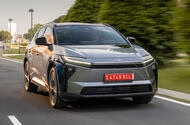The Toyota bZ4X, a key player in the electric SUV market, has had a rocky start. With initial delays, an early recall, and concerns over its battery performance in cold weather, it faced quite a bit of scrutiny. But now, with a significant facelift and a host of updates, Toyota is aiming to turn things around. Let’s dive into what’s new and whether these changes make the bZ4X a contender against rivals like the Tesla Model Y.
What’s New in the bZ4X?
First off, the exterior has received a fresh look. The front fascia now sports slimmer headlights, and the wheel-arch trims have been upgraded from unpainted black to a sleek gloss black. These changes not only enhance the vehicle’s aesthetic appeal but also signal Toyota’s commitment to improving its image in the EV market.
One of the most significant updates is the increase in battery capacity. The bZ4X now boasts a larger battery, moving from 71.4 kWh to 73.1 kWh, with 69.0 kWh usable. This boost, combined with improved efficiency, means the vehicle can now achieve a WLTP range of up to 354 miles for the single-motor version. That’s a notable jump from the previous 312 miles, making it a more competitive option for those concerned about range anxiety.
How Does It Perform?
Performance-wise, the bZ4X has seen some impressive upgrades. The dual-motor version now delivers an additional 124 bhp, dropping its 0-62 mph time by 1.8 seconds. This newfound power makes the driving experience much more exhilarating. The single-motor variant, while still adequate, remains somewhat unremarkable in comparison.
Toyota has also tweaked the driving dynamics. The engineers have made adjustments to the springs, dampers, and bushings, resulting in a more settled ride, especially for rear passengers. The bZ4X now strikes a balance between comfort and handling, making it a pleasant vehicle for everyday driving.
What About the Interior?
The interior has undergone a makeover as well. The previous glossy black center console has been replaced with a matte finish that includes two wireless charging pads—definitely a step in the right direction. The multimedia system, borrowed from the Lexus RZ, is now more user-friendly, featuring a permanent toolbar on the touchscreen that allows for easier navigation. This is a welcome change, especially for those who found the previous interface frustrating.
However, some aspects of the interior still leave something to be desired. While the new textured rubber lining on the dashboard is soft and durable, the overall look can feel a bit drab due to the sea of black materials. Space-wise, rear passengers enjoy decent knee room, but the high floor and average boot space might be a drawback for some families.
How Does It Handle Charging?
Charging has been a hot topic for the bZ4X since its launch. Thankfully, the latest updates include a pre-conditioning function that allows the vehicle to achieve peak charging speeds of 150 kW, even in colder conditions. This is crucial for winter driving, where battery performance can often dip. The single-motor version has shown impressive efficiency, returning 3.9 miles per kWh, which is commendable for a vehicle of its size.
What’s the Verdict?
While the bZ4X may not leap to the top of the electric SUV class with these updates, it has certainly become a more appealing option. The enhancements in battery capacity, performance, and interior usability make it a solid choice for those looking for a no-nonsense electric vehicle. However, it still faces stiff competition from models like the Hyundai Ioniq 5 and the Tesla Model Y, which continue to push the envelope in terms of technology and performance.
The big takeaway? The bZ4X isn’t about perfection—it’s about smarter adjustments. Start with one change this week, and you’ll likely spot the difference by month’s end.

